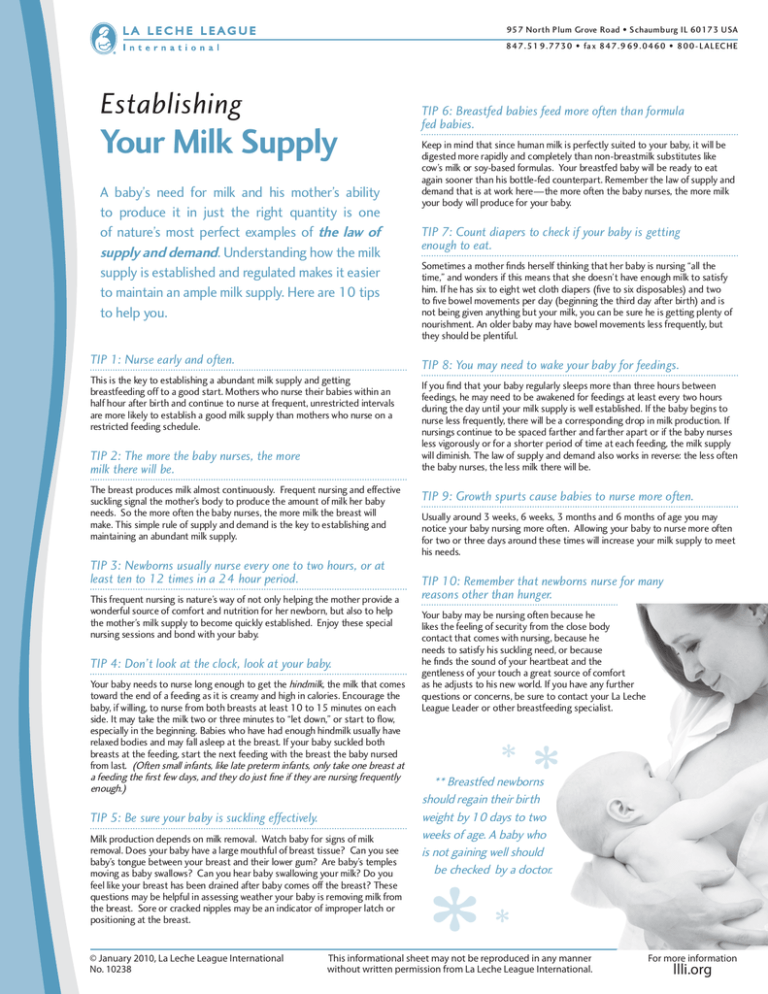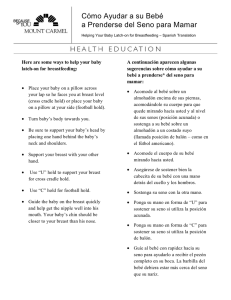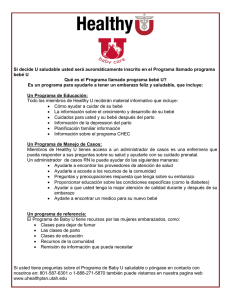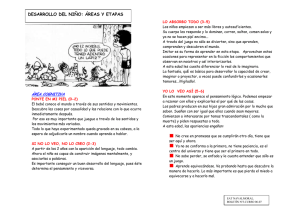Your Milk Supply - La Leche League
Anuncio

957 North Plum Grove Road • Schaumburg IL 60173 USA 847.519.7730 • fax 847.969.0460 • 800-LALECHE Establishing Your Milk Supply A baby’s need for milk and his mother’s ability to produce it in just the right quantity is one of nature’s most perfect examples of the law of supply and demand. Understanding how the milk supply is established and regulated makes it easier to maintain an ample milk supply. Here are 10 tips to help you. Tip 1: Nurse early and often. Keep in mind that since human milk is perfectly suited to your baby, it will be digested more rapidly and completely than non-breastmilk substitutes like cow’s milk or soy-based formulas. Your breastfed baby will be ready to eat again sooner than his bottle-fed counterpart. Remember the law of supply and demand that is at work here—the more often the baby nurses, the more milk your body will produce for your baby. Tip 7: Count diapers to check if your baby is getting enough to eat. Sometimes a mother finds herself thinking that her baby is nursing “all the time,” and wonders if this means that she doesn’t have enough milk to satisfy him. If he has six to eight wet cloth diapers (five to six disposables) and two to five bowel movements per day (beginning the third day after birth) and is not being given anything but your milk, you can be sure he is getting plenty of nourishment. An older baby may have bowel movements less frequently, but they should be plentiful. Tip 8: You may need to wake your baby for feedings. This is the key to establishing a abundant milk supply and getting breastfeeding off to a good start. Mothers who nurse their babies within an half hour after birth and continue to nurse at frequent, unrestricted intervals are more likely to establish a good milk supply than mothers who nurse on a restricted feeding schedule. Tip 2: The more the baby nurses, the more milk there will be. The breast produces milk almost continuously. Frequent nursing and effective suckling signal the mother’s body to produce the amount of milk her baby needs. So the more often the baby nurses, the more milk the breast will make. This simple rule of supply and demand is the key to establishing and maintaining an abundant milk supply. Tip 3: Newborns usually nurse every one to two hours, or at least ten to 12 times in a 24 hour period. This frequent nursing is nature’s way of not only helping the mother provide a wonderful source of comfort and nutrition for her newborn, but also to help the mother’s milk supply to become quickly established. Enjoy these special nursing sessions and bond with your baby. Tip 4: Don’t look at the clock, look at your baby. Your baby needs to nurse long enough to get the hindmilk, the milk that comes toward the end of a feeding as it is creamy and high in calories. Encourage the baby, if willing, to nurse from both breasts at least 10 to 15 minutes on each side. It may take the milk two or three minutes to “let down,” or start to flow, especially in the beginning. Babies who have had enough hindmilk usually have relaxed bodies and may fall asleep at the breast. If your baby suckled both breasts at the feeding, start the next feeding with the breast the baby nursed from last. (Often small infants, like late preterm infants, only take one breast at a feeding the first few days, and they do just fine if they are nursing frequently enough.) Tip 5: Be sure your baby is suckling effectively. Milk production depends on milk removal. Watch baby for signs of milk removal. Does your baby have a large mouthful of breast tissue? Can you see baby’s tongue between your breast and their lower gum? Are baby’s temples moving as baby swallows? Can you hear baby swallowing your milk? Do you feel like your breast has been drained after baby comes off the breast? These questions may be helpful in assessing weather your baby is removing milk from the breast. Sore or cracked nipples may be an indicator of improper latch or positioning at the breast. © January 2010, La Leche League International No. 10238 Tip 6: Breastfed babies feed more often than formula fed babies. If you find that your baby regularly sleeps more than three hours between feedings, he may need to be awakened for feedings at least every two hours during the day until your milk supply is well established. If the baby begins to nurse less frequently, there will be a corresponding drop in milk production. If nursings continue to be spaced farther and farther apart or if the baby nurses less vigorously or for a shorter period of time at each feeding, the milk supply will diminish. The law of supply and demand also works in reverse: the less often the baby nurses, the less milk there will be. Tip 9: Growth spurts cause babies to nurse more often. Usually around 3 weeks, 6 weeks, 3 months and 6 months of age you may notice your baby nursing more often. Allowing your baby to nurse more often for two or three days around these times will increase your milk supply to meet his needs. Tip 10: Remember that newborns nurse for many reasons other than hunger. Your baby may be nursing often because he likes the feeling of security from the close body contact that comes with nursing, because he needs to satisfy his suckling need, or because he finds the sound of your heartbeat and the gentleness of your touch a great source of comfort as he adjusts to his new world. If you have any further questions or concerns, be sure to contact your La Leche League Leader or other breastfeeding specialist. ** Breastfed newborns should regain their birth weight by 10 days to two weeks of age. A baby who is not gaining well should be checked by a doctor. This informational sheet may not be reproduced in any manner without written permission from La Leche League International. For more information llli.org 957 North Plum Grove Road • Schaumburg IL 60173 USA 847.519.7730 • fax 847.969.0460 • 800-LALECHE Estableciendo una buena producción de leche Traducido por María del Mar Mazza Revisado por Waleska Porras y Verónica Garea El mecanismo que se establece por la necesidad de un bebé de alimentarse y la habilidad de la madre de producir leche en la cantidad justa, es uno de los mejores ejemplos de la ley de la oferta y la demanda. Una vez que se entiende como se establece y se regula la producción de leche, resulta más fácil mantenerla. Aquí se listan 10 sugerencias que te resultarán útiles: Sugerencia 1: Amamanta desde un principio y con frecuencia Esta es la clave para lograr una producción abundante de leche y para que la lactancia comience sin problemas. Las madres que amamantan a sus bebés dentro de la media hora después de nacidos, y que continúan amamantando en forma frecuente, sin intervalos pre-establecidos suelen tener una buena producción de leche, en comparación con las madres que amamantan bajo un esquema estricto de horarios. Sugerencia 2: Cuanto más amamantes a tu bebé, más leche producirás El pecho produce leche casi continuamente. La succión frecuente y efectiva es una señal para el cuerpo de la madre para producir la cantidad de leche que su bebé necesita. Por lo tanto, cuanto más frecuentemente el bebé succione, más leche producirá el pecho. Esta regla tan simple de la oferta y la demanda es la clave para establecer y mantener una producción abundante de leche. Sugerencia 3: Los recién nacidos usualmente toman pecho cada una o dos horas, o al menos entre 10 a 12 veces en un período de 24 horas El hecho de amamantar tan seguido no sólo constituye una forma natural de contribuir a que la madre sea una fuente de consuelo y nutrición para su recién nacido, sino que también ayuda a que su producción de leche se establezca rápidamente. Disfruta de estas sesiones especiales, y del apego que propician entre tú y tu bebé. Sugerencia 4: No mires el reloj, mira a tu bebé Tu bebé necesita tomar pecho durante una buena cantidad de tiempo, para obtener la leche del final. La leche que aparece hacia el final de la toma es alta en calorías y de consistencia cremosa. Anima a tu bebé, si está dispuesto, a succionar de ambos pechos al menos 10 ó 15 minutos. Usualmente, la “bajada de la leche” ocurre después de los dos o tres minutos de iniciada la succión, sobre todo al principio. Los bebés que recibieron leche cremosa usualmente tienen su cuerpo relajado, y suelen quedarse dormidos en el pecho. Si tu bebé succionó de ambos pechos durante la misma toma, la próxima vez que lo amamantes ofrécele el pecho que tomó de último. (Algunos bebés, en especial los prematuros y bebés pequeños, solo toman un pecho por sesión de lactancia durante los primeros días, y no presentan problema de aumento de peso mientras tomen pecho con la frecuencia necesaria). Sugerencia 5: Asegúrate que tu bebé succione en forma efectiva La producción de leche depende de la frecuencia con que se remueve la leche de los pechos. Busca en tu bebé las señales de que logra extraer una cantidad © January 2010, La Leche League International No. 10238 significativa de leche de los pechos. Las siguientes preguntas te servirán de guía para saber si tu bebé está removiendo la leche de tu pecho. Cuando tu bebé toma el pecho, ¿observas que gran parte de su boca cubre la areola? ¿Puedes observar la lengua de tu bebé entre tu pecho y su encía inferior? ¿Observas movimiento de la sien del bebé, cuando traga? ¿Puedes oír cuando tu bebé traga la leche? ¿Sientes que tus pechos están blandos cuando tu bebé los suelta al terminar? En caso de tener pezones agrietados o adoloridos la causa podría deberse a una mala posición y un mal agarre del pecho. Sugerencia 6: Los bebés amamantados se alimentan más seguido que los bebés que toman leche industrial Ten en cuenta que la leche materna está diseñada exclusivamente para tu bebé. La digestión de la misma es más rápida y completa en comparación con los sustitutos de leche materna, como las leches industriales a base de leche de vaca o soja. Por esta razón tu bebé amamantado estará listo para volver a alimentarse antes que los bebés que reciben leche industrial. Recuerda la ley de la oferta y la demanda, la cual juega un importante papel: cuanto más seguido succione el pecho tu bebé, más leche producirás para satisfacer sus necesidades. Sugerencia 7: Cuenta los pañales para saber si tu bebé obtiene suficiente leche A veces una madre piensa que está amamantando a su bebé “todo el tiempo”, y comienza a dudar si su leche es suficiente para satisfacer sus necesidades. Si tu bebé moja entre seis a ocho pañales por día (cinco o seis desechables) y tiene de dos a cinco deposiciones (a partir del tercer día de nacido), y recibe sólo tu leche, puedes estar segura que tu bebé está obteniendo suficiente alimento. Un bebé mayorcito suele tener menos deposiciones, pero las mismas deberían ser más voluminosas. Sugerencia 8: Quizás debas despertar a tu bebé para alimentarlo Si tienes un bebé que normalmente duerme más de tres horas entre cada toma quizás sea necesario que lo despiertes para amamantarlo por lo menos cada dos horas durante el día, hasta que tu producción de leche esté bien establecida. Si tu bebé comienza a tomar pecho menos frecuentemente, tu producción de leche comenzará a bajar. Si las tomas comienzan a espaciarse cada vez más, si el bebé succiona con menos vigorosidad, o si lo hace por poco tiempo en cada toma, la producción de leche disminuirá. La ley de la oferta y la demanda también funciona a la inversa: cuanto menos pecho tome el bebé, habrá menos leche. Sugerencia 9: Los bebés toman pecho más seguido durante las etapas de crecimiento rápido Usualmente alrededor de las 3 y 6 semanas y los 3 y 6 meses de edad, podrás notar que tu bebé toma pecho más seguido. Si lo amamantas con mayor frecuencia durante dos o tres días mientras atraviesa una etapa de crecimiento rápido, se producirá un aumento en tu producción de leche para satisfacer sus necesidades Sugerencia 10: Recuerda que los recién nacidos toman pecho por varias razones, no sólo por hambre Quizás tu bebé esté tomando pecho con más frecuencia porque le agrada la sensación de seguridad que le da la cercanía a tu cuerpo, o porque necesita satisfacer la necesidad de succionar, o porque le agrada el sonido del latido de tu corazón, y la dulzura con la que lo tratas, las cuales resultan ser una fuente de paz mientras él se adapta a este nuevo mundo. Si tienes alguna pregunta, o duda, contacta a una Líder de la Liga de La Leche u otra especialista en lactancia. **Los bebés amamantados deberían volver a su peso de nacidos a los diez días o hacia las dos semanas de edad. Un bebé que no está ganando suficiente peso debe visitar a un médico. This informational sheet may not be reproduced in any manner without written permission from La Leche League International. For more information llli.org






